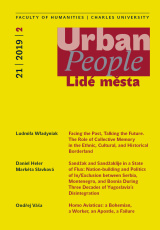Homo Aviaticus
A Bohemian, a Worker, an Apostle, a Failure
DOI:
https://doi.org/10.14712/12128112.3248Abstrakt
The essay analyses Bohemian avant‑garde poetry and popular aviation literature of the 1920s and 1930s, trying to reconstruct a typical poetic figure of the period technological imagination, i.e. the figure of “homo aviaticus”. To organize the scattered sources, the essay first outlines Jünger’s conception of “the worker” and presents him as the model aviatic figure. The key elements of this “Gestalt” – his Ahasuerian nature, his mobile and mobilizing character, and his utilization of death – serve as the key coordinates on which the essay triangulates the Bohemian “homo aviaticus” in question. The essay subsequently interprets the poetry of Vítězslav Nezval, Jaroslav Seifert, and others (the authors published in the almanacs Devětsil, Disk, Život…), and reveals their ambivalent attitude to the aviation which they seemed to praise. The last third of the essay uncovers the intrinsic ambivalence of the figure itself: while the aviatic man used to be defined in terms of his spiritual superiority, the real problems concerned his body, so that in the end, he could only meet the expectations pinned on him at the price of self‑destruction.
Stahování
Publikováno
Jak citovat
Číslo
Sekce
Licence

Tato práce je licencována pod Mezinárodní licencí Creative Commons Attribution-NonCommercial-NoDerivatives 4.0.


